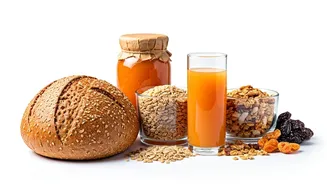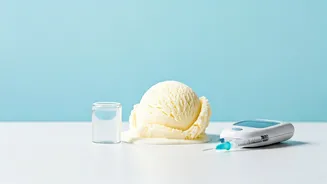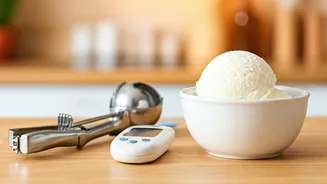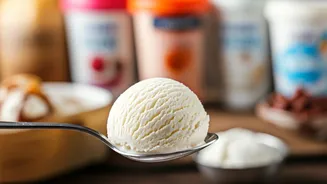Diabetes and Ice Cream
For individuals managing diabetes, understanding the effects of food on blood sugar levels is crucial. Ice cream, being a dessert often high in sugar and carbohydrates,
can significantly impact these levels. When consumed, the body breaks down carbohydrates into glucose, causing blood sugar to rise. This rise can be more pronounced with ice cream, depending on the ingredients and portion size. People with diabetes must carefully consider this aspect, as uncontrolled blood sugar can lead to various health complications. However, this does not necessarily mean complete avoidance. The key lies in making informed choices and consuming it as part of a balanced diet. Factors like the type of ice cream, the quantity consumed, and the timing of consumption are important for managing glucose responses. It is always recommended that anyone with diabetes consult with their healthcare provider or a registered dietitian for personalized advice regarding their diet and how specific foods fit into their overall health plan.
Understanding Blood Sugar
The body's reaction to carbohydrates is central to the discussion. After eating, the body converts carbohydrates from food into glucose, the primary energy source. For people with diabetes, the body either doesn't produce enough insulin (Type 1) or doesn't use insulin effectively (Type 2). Insulin is the hormone that helps glucose enter cells to be used for energy. Without enough insulin, glucose stays in the bloodstream, leading to high blood sugar levels, or hyperglycemia. Ice cream’s sugar content contributes to this process, prompting a rapid increase in blood sugar. The severity of the spike can be influenced by the type of ice cream (e.g., traditional versus low-sugar), the amount consumed, and how quickly it is eaten. Furthermore, the presence of fats and proteins in ice cream can affect how quickly the sugar is absorbed, influencing the blood sugar response over time. Monitoring blood glucose levels after eating ice cream can give valuable insights into how your body responds and helps make more informed food choices. This is especially useful in developing strategies to manage blood sugar.
Smart Consumption Strategies
Enjoying ice cream responsibly requires a proactive approach. Portion control is essential. Rather than indulging in a large serving, opt for a smaller portion size, like a half-cup or a single scoop. Carefully reading the nutrition labels on ice cream containers is a good practice. Pay close attention to the serving size, total carbohydrates, added sugars, and fat content. Comparing different brands can help in finding options that are lower in sugar and fat. Considering the timing of when you eat ice cream can also influence its impact. Having ice cream after a meal that includes protein, fiber, and healthy fats can slow down the absorption of sugar into the bloodstream. Fiber-rich foods and protein help to moderate glucose spikes. It's beneficial to include the ice cream into your overall meal plan, ensuring that it is accounted for in your daily carbohydrate and calorie intake. Moreover, keeping an eye on your blood sugar levels before and after eating ice cream can assist you in assessing how your body reacts to it, aiding you to make better choices in the future.
Choosing the Right Ice Cream
Selecting the right kind of ice cream can make a big difference for people with diabetes. Several low-sugar or sugar-free options are available in the market. These ice creams often use sugar substitutes like stevia, erythritol, or monk fruit, which have a minimal impact on blood sugar levels. When choosing these options, always check the nutrition labels to ensure they are low in carbohydrates and added sugars. Consider the fat content as well, as some low-sugar ice creams may have higher fat content to maintain texture and taste. High-fat intake can affect insulin sensitivity. Another good alternative is to look for ice cream made with natural ingredients and minimal processing. Some brands are incorporating natural sweeteners and healthier fats. Portion control remains very important, regardless of the type of ice cream. It is always important to consult with your doctor or a registered dietitian, as they can provide individual recommendations.
Recipe Considerations
Making ice cream at home gives you full control over the ingredients, providing a way to create diabetic-friendly treats. You can use sugar substitutes, incorporate fresh fruits instead of added sugar, and control the fat content. Homemade ice cream recipes can be adapted to accommodate dietary needs. For example, instead of using heavy cream, you can utilize unsweetened almond milk or coconut milk to lower the fat content. In terms of sweeteners, you can experiment with natural options like stevia or erythritol to keep sugar levels low. Adding fresh or frozen fruits like berries, which are naturally low in sugar and high in fiber, can enhance the flavor and nutritional value. Recipes that include ingredients like Greek yogurt or avocado, can provide additional protein and healthy fats, which can help in stabilizing blood sugar levels. Always measure ingredients accurately and consider the total carbohydrate count per serving. There are plenty of online resources and cookbooks with diabetic-friendly ice cream recipes for inspiration. Experimenting with different ingredients and finding recipes that suit your taste preferences is a way to make ice cream a healthy treat.













